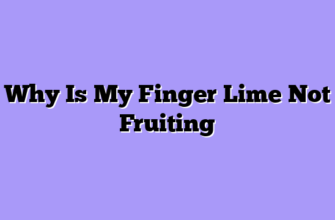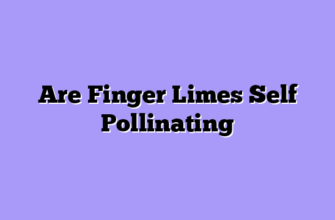When I first discovered dwarf finger lime trees, I honestly thought I’d found the holy grail of exotic fruit cultivation. Here was a plant that produced those incredible citrus caviar pearls—the same ones that chefs go crazy for—but in a size that actually fit on my patio. No massive orchard required, no endless rows of towering trees, just a compact, manageable specimen that could thrive in a container and still deliver that wow factor.
The botanical name is Citrus australasica, though you’ll hear these beauties called by many names depending on where you are and who you’re talking to. Australian finger limes, caviar limes, citrus pearls, or simply bush limes—all refer to this remarkable native Australian citrus. The dwarf varieties take all those amazing characteristics and package them into a smaller, more manageable form that’s opened up finger lime cultivation to gardeners and farmers who previously thought these trees were out of reach.
Let me be straight with you: choosing to grow dwarf cultivars of this species was one of the smartest decisions I’ve made on my farm. Whether you’re working with limited space, want the flexibility of container growing, or simply prefer trees you can manage without a ladder, these compact versions deliver everything their full-sized cousins do, just in a friendlier package.
Why Dwarf Varieties Change the Game
Think about traditional fruit trees for a moment. Most of them eventually reach heights of fifteen to twenty-five feet, requiring significant space, elaborate pruning schedules, and sometimes specialized equipment just to harvest the fruit. Standard finger lime trees fall into this category, typically growing twelve to twenty feet tall when mature. They’re gorgeous trees, don’t get me wrong, but they’re not exactly suited for small spaces or easy management.

The space-saving benefits extend beyond just height. Dwarf Citrus australasica varieties also have a more compact spread, usually staying within a three to five-foot diameter. This means you can position them closer together than standard trees, whether you’re growing in the ground or in containers. On my farm, I’ve got a section dedicated to container-grown dwarf varieties where I can fit three trees in the same footprint that one standard tree would occupy.
Key Advantages of Compact Bush Lime Cultivars:
- Manageable size allows for easier pruning, pest management, and harvesting
- Container-friendly growth habit enables cultivation in diverse settings
- Earlier fruit production compared to many standard-sized trees
- Better suited for protected growing in greenhouses or indoor spaces during cold weather
- Reduced wind damage due to lower profile and sturdier structure
- Simplified netting and frost protection when needed
- More efficient use of limited growing space
Container growing deserves special attention here because it’s where dwarf varieties truly shine. I’ve experimented with various container sizes over the seasons, and I’ve found that a fifteen to twenty-five-gallon container provides ample room for a dwarf finger lime to thrive. This is dramatically smaller than what full-sized trees require, making them easier to move, repot, and manage overall.
The mobility factor shouldn’t be underestimated, especially if you’re growing in marginal climates like I am. When unexpected late frosts threaten, I can roll my containerized dwarf caviar limes into my greenhouse within minutes. Try doing that with a tree planted in the ground or a massive container holding a standard-sized specimen!
Selecting the Right Dwarf Variety for Your Situation
Not all dwarf finger limes are created equal, and understanding the differences between available cultivars has been crucial to my success. The market for these compact trees has expanded considerably in recent years, giving growers like us more options than ever before. However, with more choices comes the need for more careful decision-making.
Some dwarf varieties are naturally compact—they’re selections or seedlings that happened to exhibit dwarfing characteristics. Others achieve their small stature through grafting onto dwarfing rootstock. Both approaches work, but they behave slightly differently and have distinct advantages and disadvantages.
Naturally compact varieties tend to be more consistent in their growth habit. They’re not fighting against their genetics to stay small; this is simply how they grow. I’ve found these to be easier to manage long-term because you’re not constantly battling vigorous growth from a scion that wants to be larger than its rootstock will allow.
Grafted dwarf trees, on the other hand, can offer other benefits. The rootstock might provide improved disease resistance, better cold tolerance, or enhanced productivity. I have several grafted dwarf Australian finger limes that outproduce my naturally compact ones simply because they’re on particularly vigorous, productive rootstock that channels all that energy into flowering and fruiting rather than excessive vegetative growth.
Popular Dwarf Cultivars and Their Characteristics
Let me walk you through some varieties I’ve worked with and what I’ve observed about each:
| Variety Name | Mature Height | Fruit Color | Flavor Profile | Best For |
|---|---|---|---|---|
| Little Ruby | 4-6 feet | Pink to red pearls | Tart, citrusy with floral notes | Containers, patios, small gardens |
| Compact Judy | 5-7 feet | Green to yellow | Balanced sweet-tart | General cultivation, reliable producer |
| Dwarf Rainforest Pearl | 4-6 feet | Light pink | Mild, slightly sweet | Culinary use, fresh eating |
| Mini Crimson | 3-5 feet | Deep red | Intensely tart | Garnishes, cocktails, cooking |
The Little Ruby has become one of my personal favorites for container growing. Its compact habit is remarkably consistent, rarely exceeding five feet even after several seasons of growth. The fruit quality is exceptional—those rosy pearls have a complexity that works beautifully in both sweet and savory applications. I’ve supplied these to several local restaurants whose chefs specifically request them for their color and flavor.
Compact Judy, a dwarf version of the popular Judy’s Everbearing, lives up to its name by producing fruit multiple times throughout the year. While it grows slightly larger than Little Ruby, its productivity more than compensates for the extra foot of height. This variety has proven particularly valuable for my commercial operation because that extended harvest window means more consistent income rather than one big flush of fruit.
Growing Requirements and Ongoing Care
Here’s where I’m going to share the real-world experience that only comes from actually growing these trees, not just reading about them. Dwarf finger limes have specific needs, and meeting those needs determines whether you’ll have a thriving tree or a struggling one.
Step-by-Step Establishment Process:
- Choose your growing location or container – Select a spot with full sun exposure (at least 6-8 hours daily) and excellent drainage, or prepare a container with drainage holes and quality potting mix
- Prepare proper soil or growing medium – Mix together quality potting soil, perlite or pumice for drainage (30% of total volume), and aged compost (10-15% of volume) to create an ideal growing environment
- Plant at the correct depth – Position your tree so the graft union (if grafted) sits 2-3 inches above soil level; never bury the graft union as this can cause rootstock suckering
- Water thoroughly after planting – Saturate the root zone completely, allowing water to drain freely, then establish a consistent watering schedule based on soil moisture
- Apply initial fertilizer – Wait 2-3 weeks after planting, then begin feeding with a citrus-specific fertilizer at half the recommended strength
- Mulch appropriately – Add 2-3 inches of organic mulch around the base, keeping it several inches away from the trunk to prevent rot issues
- Monitor for pests and disease – Check weekly for common issues like aphids, scale, or leaf miners, addressing problems early before they escalate
Light requirements for these compact Citrus australasica specimens are non-negotiable in my experience. Full sun means full sun—at least six hours of direct sunlight daily, though eight to ten hours produces even better results. I learned this lesson with my first few dwarf trees when I tried positioning them in partial shade, thinking their compact size might make them more shade-tolerant. Wrong. They languished, produced minimal fruit, and showed weak, leggy growth. Once I moved them to full sun locations, everything changed.
Water management takes some finesse, especially in containers. The soil should dry slightly between waterings but never completely. I use the finger test—stick your finger into the soil up to the second knuckle. If it feels dry at that depth, it’s time to water. In summer heat, my containerized dwarf bush limes need water almost daily. During cooler months, every three to four days suffices.
Fertilization Schedule and Nutritional Needs
Feeding these trees properly has probably had the biggest impact on my success rates. Citrus are moderate to heavy feeders, and dwarf varieties are no exception. In fact, because they’re often container-grown where nutrients leach away more quickly, they may need more frequent fertilization than in-ground trees.
I follow a seasonal approach that’s served me well:
| Season | Fertilizer Type | Frequency | Notes |
|---|---|---|---|
| Spring | High-nitrogen citrus blend | Every 3 weeks | Support vigorous growth flush |
| Summer | Balanced citrus formula | Every 2-3 weeks | Maintain steady growth, support fruit development |
| Fall | Low-nitrogen, higher phosphorus | Every 4 weeks | Harden growth before winter, support flowering |
| Winter | Minimal or none | Every 6-8 weeks (if needed) | Reduce feeding when growth naturally slows |
Beyond the regular feeding schedule, I supplement with foliar sprays of micronutrients—especially iron, zinc, and manganese—every four to six weeks during the growing season. Citrus are notorious for showing micronutrient deficiencies, particularly when grown in containers, and addressing these issues before they become severe keeps my trees healthy and productive.
Pruning dwarf caviar limes is actually one of my favorite tasks because it’s so straightforward compared to managing full-sized trees. The compact habit means most pruning focuses on maintaining shape, removing dead or damaged wood, and occasionally thinning to improve air circulation. I avoid heavy pruning during the main growing season, preferring to do any significant shaping in late winter or early spring before new growth begins.
One technique I’ve developed specifically for my container-grown dwarf specimens is what I call “rotational pruning.” Every few months, I’ll selectively prune one section of the tree—maybe a quarter of its canopy—removing older wood and encouraging fresh growth. This distributes the pruning stress over time and helps maintain more consistent flowering and fruiting rather than causing a synchronized flush that can overwhelm the tree.
Harvesting and Production Expectations
Let’s talk about the bottom line: when will you get fruit, and how much can you expect? This is where dwarf Citrus australasica trees offer some pleasant surprises compared to their full-sized relatives.
Most dwarf varieties begin producing fruit within two to three years from planting, assuming they’re grafted trees from a reputable nursery. This is actually faster than many standard-sized finger limes, which can take three to five years or longer. The reason? Dwarf trees reach mature size more quickly and can direct their energy toward reproduction rather than continuing vegetative growth.
Production quantities obviously differ from standard trees—you’re not going to harvest bushels of fruit from a four-foot-tall plant. But the yields can be surprisingly respectable. My mature dwarf specimens typically produce anywhere from two to six pounds of fruit annually, with some exceptional trees exceeding eight pounds in optimal conditions. That might not sound like much compared to commercial citrus operations, but when you consider that finger limes retail for fifteen to thirty dollars per pound, we’re talking about meaningful production.
The harvest season varies by cultivar and climate, but most Australian finger limes ripen from late fall through spring in my region. Dwarf varieties follow this same pattern, though some like Compact Judy produce sporadically throughout the year. Knowing when fruit is ripe takes practice—the skin should yield slightly to pressure and, depending on variety, may show slight color changes. I’ve learned to trust my sense of touch more than appearance because some varieties don’t show obvious color shifts when ripe.
Here’s something crucial I’ve learned about maximizing production: flower and fruit thinning matters, even on dwarf trees. When my trees set heavy crops, I thin the fruit clusters to ensure the remaining ones size up properly and the tree doesn’t exhaust itself. I aim for spacing of two to three inches between fruits, removing the smallest or most damaged ones. Yes, it feels counterintuitive to remove potential fruit, but the end result is larger, higher-quality caviar limes and a healthier tree that produces consistently year after year.
Problem-Solving and Common Challenges
Even with proper care, issues arise—that’s just the reality of farming. However, the compact size of dwarf bush limes actually makes many problems easier to spot and address compared to full-sized trees.
Pest pressure has been my most consistent challenge. Aphids absolutely love the tender new growth that citrus produces, and they can establish colonies seemingly overnight. The advantage with dwarf trees? I can spot them immediately and address them quickly. A strong blast of water dislodges most aphids, and for stubborn infestations, insecticidal soap applied according to label directions does the trick.
Scale insects present a more insidious problem because they’re less obvious and can build up slowly over time. I check my dwarf Citrus australasica trees monthly for these pests, looking for small bumps on stems and the undersides of leaves. Horticultural oil applications work well for control, though they require good coverage and sometimes multiple treatments.
Leaf miners are another common pest that creates those characteristic squiggly trails through leaves. While they look terrible, they rarely cause serious damage to established trees. I tolerate low levels of leaf miner damage because controlling them often requires more chemical intervention than I’m comfortable with for home-scale production.
Disease issues have been relatively minimal on my dwarf varieties, probably because the compact size and container growing allow for better air circulation and faster drying after rain or irrigation. I have occasionally dealt with root rot in trees that were overwatered or had poor drainage—reinforcing why proper watering practices and well-draining soil are absolutely critical.
Cold damage is perhaps the most serious threat I face with these subtropical natives. While mature Citrus australasica can handle brief dips into the upper twenties Fahrenheit, dwarf varieties in containers are more vulnerable because their roots are exposed. I bring my containerized trees into protected areas when temperatures threaten to drop below thirty degrees, and I cover any in-ground specimens with frost blankets.
The Economics and Practicality of Dwarf Cultivation
From a business perspective, dwarf finger limes have proven to be excellent additions to my farm. The initial investment is higher than many fruit trees—quality dwarf specimens typically run sixty to one hundred fifty dollars depending on size and variety—but the return on that investment can be quite favorable.
Let me break down some real numbers from my operation. A mature dwarf tree producing five pounds of fruit annually, with fruit selling at an average of twenty dollars per pound, generates one hundred dollars in gross revenue. If I have ten dwarf trees in containers that occupy the same space as three standard trees, that’s one thousand dollars versus potentially more from the standard trees, but the dwarf trees started producing sooner and require less maintenance time.
The flexibility factor adds value that’s harder to quantify. Being able to move trees, protect them easily, and manage them without ladders or specialized equipment saves time and reduces risk. I’ve calculated that I spend about forty percent less time on maintenance per dwarf tree compared to a standard-sized tree, which means I can manage more trees overall or dedicate that time to other high-value crops.
For home growers, the economics look even more compelling. If you’re buying finger limes at retail prices—often thirty to fifty dollars per pound—even a modest home harvest from one or two dwarf trees can pay for the initial investment within two to three years. Plus, you get the satisfaction of growing something truly special that most people have never even tasted.
Final Thoughts on These Remarkable Compact Trees
As I reflect on my experience growing dwarf finger limes—scientifically known as Citrus australasica—I’m convinced they represent one of the best options for anyone interested in exotic fruit cultivation. Whether you call them caviar limes, Australian finger limes, or bush limes, these compact versions bring all the magic of their full-sized cousins while eliminating many of the challenges.
The beauty of these trees extends beyond just their fruit. The dense, fine foliage is attractive year-round. The small, delicate flowers, while not showy, have a subtle fragrance that I find delightful. And watching those elongated fruits develop and gradually ripen never gets old, even after countless harvests.
If you’re considering adding dwarf varieties to your garden or farm, I encourage you to take the plunge. Start with one or two trees in containers so you can learn their needs without a huge commitment. Choose varieties suited to your climate and intended use. And most importantly, be patient—these trees reward good care with years of productive harvests.
The world of citrus caviar is no longer limited to commercial orchards with acres of land. Thanks to dwarf Citrus australasica cultivars, anyone with a sunny spot and a container can grow these extraordinary fruits. That democratization of exotic fruit growing is something I find genuinely exciting, and I hope more people discover the joy of harvesting their own citrus pearls from compact, manageable trees that fit perfectly into modern gardens and small farms.








